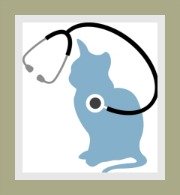Cat Diarrhea
Symptoms and Diagnosis
Cat diarrhea should be taken seriously.
We review the various aspects of
diarrhea - the symptoms, when it's critical to seek veterinary advice and how the condition is diagnosed.
feline diarrhea symptoms
There are many causes of feline diarrhea.
The type of diarrhea and associated symptoms will vary depending on which part of the bowel is involved:
- the small intestine or
- large intestine.
general feline diarrhea signs
- Frequent watery stools and increased volume of stools
- Polydipsia - increased thirst due to loss of fluids from the body
- Due to excess loss of fluid, the cat will become listless and dehydrated
- The mouth and gums will become dry
- If the skin between the shoulders is lifted and does not move back quickly, but instead causes 'tenting' the cat is severely dehydrated
- Loss of appetite
- Vomiting may or may not accompany the diarrhea

large intestine involvement (symptoms)
- There is a huge increase in the frequency of bowel movements, but the volume of stool passed may be normal or only slightly increased
- The cat will strain when passing feces
- The passing of mucus and fresh blood is common
- The cat will generally not pass gas (limited or no flatulence)
- There is no associated weight loss or vomiting
small intestine involvement (symptoms)
- There is an increase in the volume of diarrhea, but the bowel movements are not frequent
- Generally the cat will not strain when defecating
- The stool will not have any mucus present
- The stool may be 'tarry' and black which is indicative of old digested blood
- Vomiting may be present and the cat may have flatulence (gas)
- The cat is likely to present with weight loss
when to seek veterinary advice
If your cat passes one loose stool this is not indicative of feline diarrhea, but you will need to observe your kitty closely to determine the consistency and frequency of the stool.
-
Kittens with diarrhea need urgent attention
- If the diarrhea is persistent meaning your cat passes frequent watery stools in a couple of hours
- If you suspect that your cat has been accidentally or deliberately poisoned
- If your cat has a rectal prolapse i.e. part of the rectum protrudes through the anus
- If the diarrhea is accompanied by vomiting as this increases the chances of severe, life-threatening dehydration
- If the stools contain fresh blood or stools that are black and tarry
- If the stools contain jelly-like mucus or are greasy looking
- If the color of the stool changes to yellow, green or black
- f your cat's gums are pale or yellow
- If the third eyelid partially covers the eyes
- If your cat is in pain, has abdominal discomfort and has a fever
- If your cat is stressed or listless
diagnosis of cat diarrhea
The veterinarian will need to determine the cause of diarrhea before he can effectively treat your cat.
You, the cat owner, will have to prepare yourself for a host of questions that will assist the veterinarian in establishing the cause of the diarrhea.
There are a number of tests or
examinations that the veterinarian may need to perform.
- The veterinarian will take a full medical history from you, the cat owner. (Age of the cat; vaccination history, diet, signs and symptoms and details about the diarrhea i.e. color, frequency and consistency)
- The veterinarian will conduct a thorough physical examination of your cat
- A feces sample will be obtained for microscopic examination or laboratory testing
- Blood samples may be taken to test for various bacterial, viral and systemic diseases
- Ultrasound or X-rays may be required to determine if your cat has an obstruction or tumor
- It may be necessary to perform an endoscopy and to biopsy a section of the intestinal wall to confirm diagnosis of the cat diarrhea.
All the tests and investigations are necessary as diarrhea is just one of many feline illnesses symptoms. The vet needs to make the correct diagnosis in order to provide the appropriate cat diarrhea treatment.
Related Pages:
Top of Cat Diarrhea Page
Return to Feline Diarrhea
search our site
please like us
share our site
recommend on google
favorite pages





